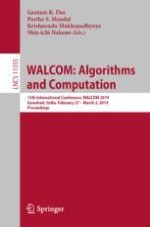2019 | Buch
WALCOM: Algorithms and Computation
13th International Conference, WALCOM 2019, Guwahati, India, February 27 – March 2, 2019, Proceedings
herausgegeben von: Gautam K. Das, Partha S. Mandal, Krishnendu Mukhopadhyaya, Shin-ichi Nakano
Verlag: Springer International Publishing
Buchreihe : Lecture Notes in Computer Science
